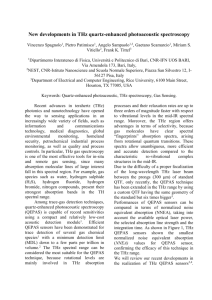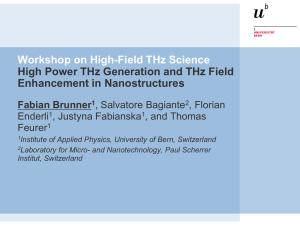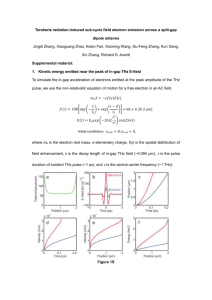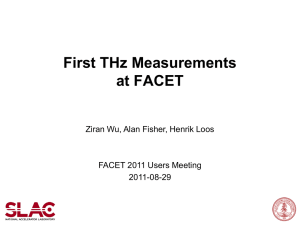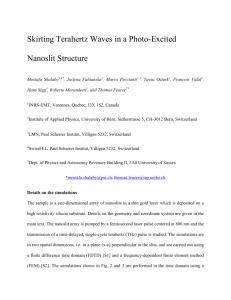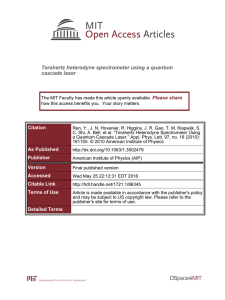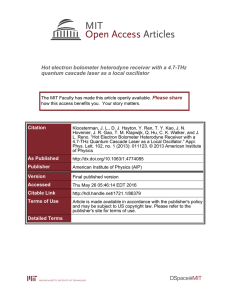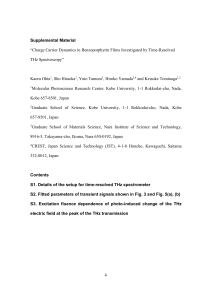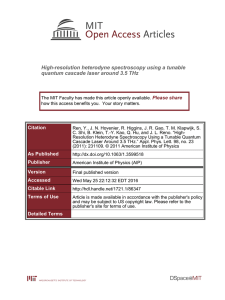A Low Cost Upper atmosphere Sounder (LOCUS) mission
advertisement
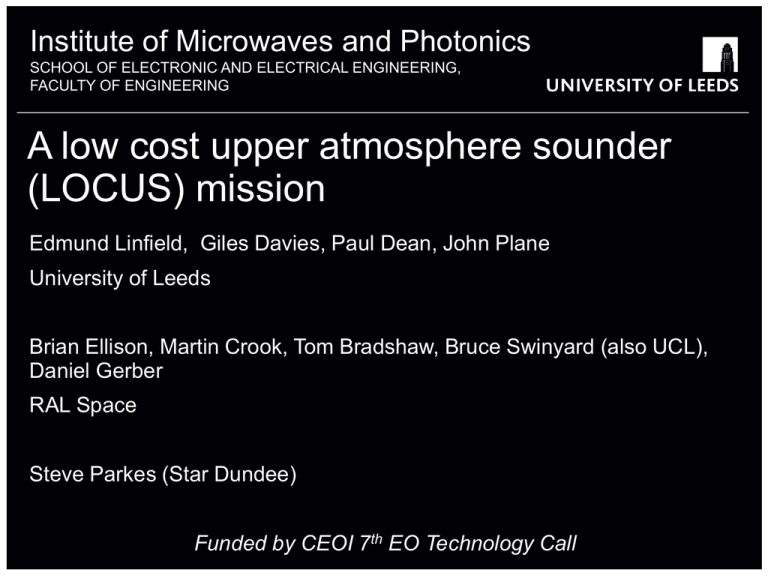
Institute of Microwaves and Photonics SCHOOL OF ELECTRONIC AND ELECTRICAL ENGINEERING, FACULTY OF ENGINEERING A low cost upper atmosphere sounder (LOCUS) mission Edmund Linfield, Giles Davies, Paul Dean, John Plane University of Leeds Brian Ellison, Martin Crook, Tom Bradshaw, Bruce Swinyard (also UCL), Daniel Gerber RAL Space Steve Parkes (Star Dundee) Funded by CEOI 7th EO Technology Call So what is LOCUS? A breakthrough concept multi-terahertz remote sounder Compact payload to be flown on a ‘standard’ small satellite that will: • Measure key species in the upper atmosphere, i.e. the mesosphere and lower thermosphere (MLT); • Increase understanding of natural and anthropogenic effect on climate change; • Allow study of the ‘gateway’ between the Earth’s atmosphere and near space environment. Small satellite sounder from LEO Why use terahertz sounding? • Terahertz (THz) frequencies (sub-mm-waves) penetrate dielectric media opaque at most other shorter wavelengths; • Can detect and characterize molecular species through obscurants and located in a relatively low temperature environment; • Offers higher spatial resolution than microwave/mm-wave range; • Allows remote sounding of atmospheric constituents related to climate change on a local or global basis; • Same technique provides information on the interstellar media, e.g. regions of star formation. What science will be investigated? LOCUS science achieved through: • Tracing O, OH, NO, CO, O3, H2O, HO2, O2 spectral emission signatures globally and from low Earth orbit (LEO); • Using a limb sounding technique with cold space as a background to achieve height distribution; • Provision of ultra-high spectral resolution (1MHz); • Accurate spatial sampling with ~2km footprint at tangent heights from ~ 55km to 150km. Species O OH But, this requires terahertz instrumentation: HO2 NO CO O2 Transition Frequency (THz) 4.745 3.544 3.543 3.544 1.153 1.153 1.152 0.773 And therein lies one challenge… IMPATT – Impact Ionization Avalanche Transit-Time diode HG – Harmonic Generation RTD – Resonant-Tunnelling Diode TPO – THz Parametric Oscillator PCS – Photoconductive Switch QCL – Quantum Cascade Laser M. Tonouchi, Nature Photonics, 1, 97 (2007) LOCUS Instrumentation To be based on heterodyne receiver technology, which converts THz input signal to a lower intermediate frequency (IF) – typically GHz; Provides low noise and high spectral resolving power - order >>104; Key front-end components are the mixer and THz local oscillator (LO). The heterodyne approach Optimum system performance requires: o Efficient signal frequency translation, i.e. low conversion loss; o Minimal added system electrical noise; o Provision of adequate THz LO source power. e.g. RAL & STAR Dundee 350GHz Heterodyne Radiometer (previous CEOI funding) The LOCUS payload concept Key features: • Highly integrated multi-channel THz radiometer system; • Four separate bands identified that accommodate the required spectral windows; • Schottky semiconductor diode mixer technology; • Quantum Cascade Laser used a LOs for 1 and 2, harmonic up-conversion for 3 and 4; • Fast Fourier Transform digital spectrometers provide 1MHz spectral resolution; • Single primary ~ 40cm diameter and miniature coolers – 100K operational goal; • UK sourced technology with critical elements support by the CEOI and NERC. Electronic behaviour 2 QCLs Peak performance corresponds to efficient injection of current Device dimensions are typically 1 mm × 150 μm × 10 μm Quantum Cascade Lasers (2) • Precise frequencies can be defined using periodic gratings defined into the ridge waveguides; 1.5 10 K 20 K 30 K 40 K 50 K 60 K 70 K 80 K 90 K 100 K 110 K 118 K 18 Voltage (V) • QCLs have an intrinsically narrow linewidth (<20 kHz); 24 12 • Radiation hardness has been demonstrated. HR 1.0 0.5 6 x40 0.0 0 0 • Operation has been demonstrated over the 1 – 5 THz frequencies; 425 um x 4.2 mm Power (W) • 1 W peak power is possible, and 10s of mW continuouswave power, but cooled; 200 400 600 800 2 Current density (A/cm ) 2% duty cycle; ;asing up to 1.01 W (peak) at ~ 3.4 THz; > 400 µW at 77 K, Tmax = 118 K: L. Li et al, Electronics Letters 50, 309 (2014). LOCUS Core Technology Schottky Barrier Diode & Space Coolers RAL QCL Local Oscillator University of Leeds Digital Spectrometer STAR-Dundee UK also leading LOCUS science definition via Leeds, UCL and RAL Small Satellite Surrey Satellites Ltd In-orbit demonstration – satellite concept Objective: Prove core payload and platform technology in space: • Polar sun synchronous orbit; • Perform global species measurement; • Novel approach to scene scanning via spacecraft nodding; • Cold-space view and on-board c300K target provide payload calibration; • Approx. total spacecraft volume, mass & power: 1m3, 150kg, 70W. o Compare with NASA AURA @ 43m3, 3tonne, 4kW & MLS: ~8m3, 500kg, 550W); • IOD mission lifetime ~ 2 years, tbc. Mission Concept Development Plan Funding (with thanks) ESA In-orbit Demonstration Study Programme (SSTL PI): • Science refinement; • Payload concept definition; • Spacecraft concept definition; • Mission plan and cost estimate. NERC Critical Component Development (RAL PI): • QCL development and waveguide demonstration; • THz Schottky diode development; • Integrated QCL & Schottky proof of concept. CEOI-ST Critical Payload Development (Leeds PI): • 1.1 THz (Band 3) full development including: o Mixer, LO and spectrometer; • QCL frequency stabilisation. Summary • THz remote sounding provides important information in relation to the Earth’s climate evolution and its monitoring; • The THz detection method depends upon the nature of the defined science return; • Where the science requires high spectral resolution and high sensitivity, THz heterodyne detection is the instrumentation of choice; • In the 1 to 5 THz frequency range, novel heterodyne instrumentation is being conceived and developed that will allow novel scientific study; • A UK initiated and presently majority UK funded instrument, LOCUS, is being developed to study the relatively unexplored supra-THz spectral range. The LOCUS Team Members Thank you for your attention


